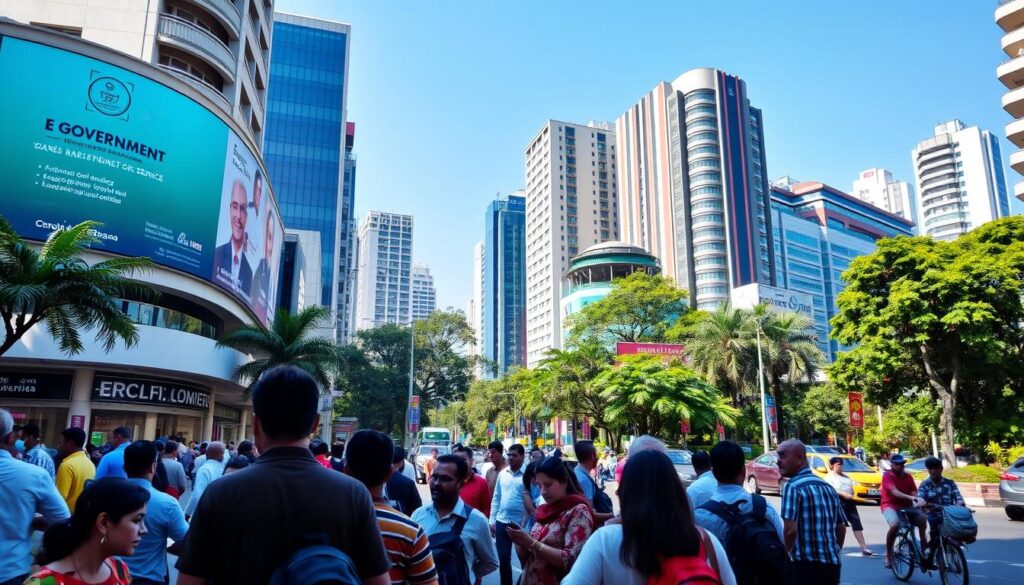Government Launches National Digital Transformation Roadmap
The Sri Lankan Government has launched a big plan for the future. They call it the National Digital Transformation Initiative. This plan is a detailed blueprint aimed at making Sri Lanka’s economy more digital by 2030. It highlights the importance of Digital Strategy Development for sustainable growth. It guides Sri Lanka into a new era of digital innovation and transformation.
The main goal is to create a National Digital Infrastructure Plan. It’s about making digital access fairer and improving public services quickly. The plan includes several stages over five years, linking well with the country’s overall development plans. It looks at how digital technology can change public services, like education, for the better. This makes governance smarter, more connected, and efficient.
The strategy draws inspiration from Uganda’s Digital Uganda Vision 2040. It has high aims, like boosting the contribution of ICT to the GDP. The plan fosters a place where digital skills, innovation, and creating businesses are key. This fits well with the world moving more towards a digital era, with blockchain and AI changing how things are done in government and education.
Key points of this plan include teaching people more about digital technology, improving online safety, protecting data, and providing better internet access. It was made by six groups working together, each focusing on different parts of putting the plan into action. The result is a broad plan to change Sri Lanka’s digital base into something stronger, more open, and forward-thinking.

OMP Sri Lanka ensures people know about important plans like the National Digital Transformation Roadmap. This plan marks a big step towards closing the digital gap between city and country areas. It prepares young people for the future and uses ICT to improve society and the economy. The plan also strongly focuses on making the country more able to deal with challenges, like the recent school closures due to floods. It highlights the need for better national defenses against natural disasters.
Exploring Sri Lanka’s 2030 Vision for Digital Transformation
Sri Lanka is on a journey towards digital progress with the National Digital Transformation Roadmap. This roadmap focuses on upgrading technology and government systems. It also aims to boost Economic Growth and make digital tools available across public services.
The National Digital Transformation Roadmap is key for Sri Lanka’s growth. It uses Digital Innovation in Public Sector to make the country competitive globally. The plan includes improving infrastructure and digital skills. It will also bring in new Digital Financial Services for more development.
The Influence of the National Digital Transformation Roadmap on the Economy
With this roadmap, Sri Lanka plans to upgrade its digital set-up. Key projects, like the City of Dreams, will help grow the economy by pulling in investors and tourists. Global rankings, like the Network Readiness Index, show that better digital systems can lift a country’s economy. This suggests Sri Lanka’s plans are on the right track.
Core Principles and Strategic Focus Areas of the Digital Roadmap
The roadmap stands on principles like inclusivity and sustainability. It aims to improve digital government services and cybersecurity. By launching Public Sector Innovation projects, it will upgrade technology in many areas.
Aligning Digital Initiatives with Sustainable Development Goals
The roadmap also supports eco-friendly tech and tries to bring digital tools to more people. It includes steps to update farming with tech, as shown by digital agritech projects.
This broad strategy not only lifts Sri Lanka’s economy. It also matches global goals for a sustainable future. That’s why Sri Lanka’s digital changes are crucial for its development.
| Indicator | 2020 Ranking | 2022 Ranking |
|---|---|---|
| ITU Global Cybersecurity Index | 83 out of 194 | Improving Measures |
| UN E-Government Development Index | 85 out of 193 | 95 out of 193 |
| Network Readiness Index | 83 out of 134 | 81 out of 131 |
Sri Lanka’s 2030 Vision for Digital Transformation seeks a balance in using digital tech for development. This roadmap clearly outlines how to modernize the public sector and promote economic and tech growth.
Driving Innovation and Inclusivity Through Digital Strategy Development
Sri Lanka focuses on creating an Inclusive Digital Economy and boosting Digital Literacy. The goal is to Bridge the Digital Divide nationwide. Making high-speed broadband available to everyone at affordable rates is key. This move aims for speeds over 100 Mbps. This will allow all government services to go online. This means citizens and businesses can easily do transactions online. With a smart approach to budget management, Sri Lanka is modernizing its economy and addressing its money challenges.
Fostering Digital Literacy and Bridging the Digital Divide
The government is improving technology to gain people’s trust in digital services. It is also focused on eco-friendly projects. This is to make digital systems more sustainable. Sri Lanka is making great progress in Digital Transformation. It’s improving access and use of digital tech. These changes will open new doors for everyone, supporting Sri Lanka’s digital infrastructure goals.
Utilizing Emerging Technologies for Economic Growth
The world’s economy is quickly changing, with digital platforms leading the way. Sri Lanka knows it needs to use Emerging Technologies for Economic Growth. The country is updating laws and policies to support digital developments. This will help Sri Lanka become a leader in digital policies and governance by 2025.
Public-Private Partnerships in National Digital Infrastructure
Public-Private Partnerships (PPPs) are crucial for Sri Lanka’s digital plans. These partnerships help overcome resource challenges. They make it easier for private investors to fund digital projects. Together, the government, schools, and businesses are expanding digital access to countryside areas. With help from groups like the World Bank and Asian Development Bank, Sri Lanka is growing. It aims to become a key business area in South Asia, focusing on strong health strategies and sustainability.



